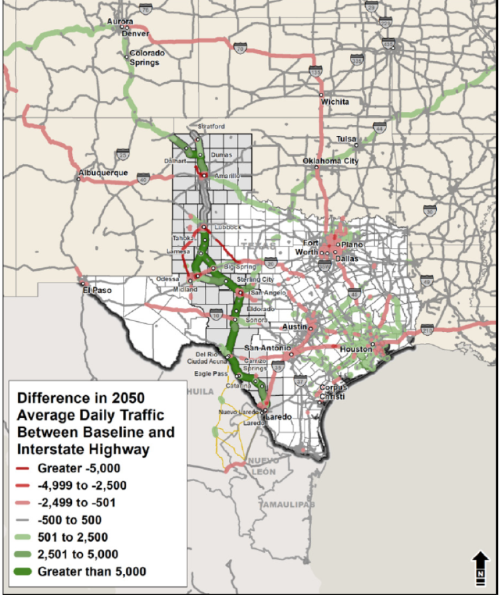|
The interstate upgrade of the Ports-to-Plains Corridor in Texas results in relatively higher speeds throughout the corridor. As a result, traffic would divert from parallel and intersecting roadways to take advantage of the improved travel time on the Ports-to-Plains Corridor.
Regional Diversion: Most diversion to the Ports-to-Plains Corridor comes from highways within 100 miles of the corridor. The interstate upgrade shows a stronger traffic diversion capability over the baseline indicating the ability to reduce traffic congestion from nearby corridors and from other corridors in the state. In Segment #1, between the New Mexico and Oklahoma borders and the Hale/Lubbock County line, the interstate upgrade diverts east/west trips from the US 57 (Eagle Pass to San Antonio) and US 90 (Del Rio to San Antonio) corridors and attracts north/south trips from US 83, SH 55, and 1-35 between Laredo and San Antonio. In Segment #2, between Hale/Lubbock County line and the Sutton/Edwards County line, the interstate upgrade also shows a significant forecasted traffic diversion from routes south of Lubbock such as US 385, US 84, and SH 137. In Segment #3, between the Sutton/Edwards County line and the I-35/Juarez-Lincoln Bridge in Laredo, the interstate upgrade diverts east/west trips from the US 57 (Eagle Pass to San Antonio) and US 90 (Del Rio to San Antonio) corridors. The interstate upgrade also attracts north/south trips from US 83, SH 55, and I-35 between Laredo and San Antonio. Diversion shown in Ports-to-Plains Interstate Feasibility Study.
0 Comments
Leave a Reply. |
Categories
All
Archives
December 2023
|


 RSS Feed
RSS Feed
